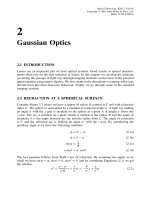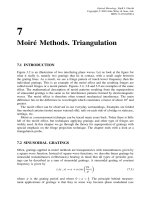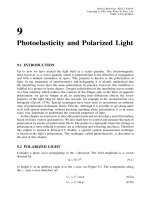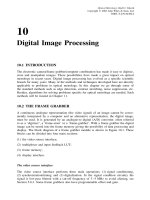Đo lường quang học P3
Bạn đang xem bản rút gọn của tài liệu. Xem và tải ngay bản đầy đủ của tài liệu tại đây (321.71 KB, 29 trang )
3
Interference
3.1 INTRODUCTION
The superposition principle for electromagnetic waves implies that, for example, two
overlapping fields u
1
and u
2
addtogiveu
1
+ u
2
. This is the basis for interference.
Because of the slow response of practical detectors, interference phenomena are also a
matter of averaging over time and space. Therefore the concept of coherence is intimately
related to interference. In this chapter we will investigate both topics. A high degree of
coherence is obtained from lasers, which therefore have been widely used as light sources
in interferometry. In recent years, lack of coherence has been taken to advantage in a
technique called low-coherence or white-light interferometry, which we will investigate
at the end of the chapter.
3.2 GENERAL DESCRIPTION
Interference can occur when two or more waves overlap each other in space.
Assume that two waves described by
u
1
= U
1
e
iφ
1
(3.1a)
and
u
2
= U
2
e
iφ
2
(3.1b)
overlap.
The electromagnetic wave theory tells us that the resulting field simply becomes the
sum, viz.
u = u
1
+ u
2
(3.2)
The observable quantity is, however, the intensity, which becomes
I =|u|
2
=|u
1
+ u
2
|
2
= U
2
1
+ U
2
2
+ 2U
1
U
2
cos(φ
1
− φ
2
)
= I
1
+ I
2
+ 2
I
1
I
2
cos φ (3.3)
where
φ = φ
1
− φ
2
(3.4)
Optical Metrology. Kjell J. G
˚
asvik
Copyright
2002 John Wiley & Sons, Ltd.
ISBN: 0-470-84300-4
38
INTERFERENCE
As can be seen, the resulting intensity does not become merely the sum of the inten-
sities (= I
1
+ I
2
) of the two partial waves. One says that the two waves interfere and
2
√
I
1
I
2
cos φ is called the interference term. We also see that when
φ = (2n + 1)π, for n = 0, 1, 2,...
cos φ =−1andI reaches its minima. The two waves are in antiphase which means
that they interfere destructively.
When
φ = 2nπ, for n = 0, 1, 2,...
cos φ = 1 and the intensity reaches its maxima. The two waves are in phase which
means that they interfere constructively.
For two waves of equal intensity, i.e. I
1
= I
2
= I
0
, Equation (3.3) becomes
I = 2I
0
[1 + cos φ] = 4I
0
cos
2
φ
2
(3.5)
where the intensity varies between 0 and 4I
0
.
3.3 COHERENCE
Detection of light (i.e. intensity measurement) is an averaging process in space and time.
In developing Equation (3.3) we did no averaging because we tacitly assumed the phase
difference φ to be constant in time. That means that we assumed u
1
and u
2
to have
the same single frequency. Ideally, a light wave with a single frequency must have an
infinite length. Mathematically, even a pure sinusoidal wave of finite length will have a
frequency spread according to the Fourier theorem (see Appendix B). Therefore, sources
emitting light of a single frequency do not exist.
One way of illustrating the light emitted by real sources is to picture it as sinusoidal
wave trains of finite length with randomly distributed phase differences between the
individual trains.
Assume that we apply such a source in an interference experiment, e.g. the Michelson
interferometer described in Section 3.6.2. Here the light is divided into two partial waves
of equal amplitudes by a beamsplitter whereafter the two waves are recombined to interfere
after having travelled different paths.
In Figure 3.1 we have sketched two successive wave trains of the partial waves. The
two wave trains have equal amplitude and length L
c
, with an abrupt, arbitrary phase dif-
ference. Figure 3.1(a) shows the situation when the two partial waves have travelled equal
path lengths. We see that although the phase of the original wave fluctuates randomly, the
phase difference between the partial waves 1 and 2 remains constant in time. The result-
ing intensity is therefore given by Equation (3.3). Figure 3.1(c) shows the situation when
partial wave 2 has travelled a path length L
c
longer than partial wave 1. The head of the
wave trains in partial wave 2 then coincide with the tail of the corresponding wave trains
in partial wave 1. The resulting instantaneous intensity is still given by Equation (3.3), but
now the phase difference fluctuates randomly as the successive wave trains pass by. As
COHERENCE
39
(a)
(b)
(c)
L
c
1
2
1
2
1
2
L
c
L
c
c
t
L
c
L
c
L
c
Figure 3.1
a result, cos φ varies randomly between +1and−1. When averaged over many wave
trains, cos φ therefore becomes zero and the resulting, observable intensity will be
I = I
1
+ I
2
(3.6)
Figure 3.1(b) shows an intermediate case where partial wave 2 has travelled a path
length l longer than partial wave 1, where 0 <l<L
c
. Averaged over many wave trains,
the phase difference now varies randomly in a time period proportional to τ = l/c and
remains constant in a time period proportional to τ
c
− τ where τ
c
= L
c
/c. The result is
that we still can observe an interference pattern according to Equation (3.3), but with a
reduced contrast. To account for this loss of contrast, Equation (3.3) can be written as
I = I
1
+ I
2
+ 2
I
1
I
2
|γ(τ)| cos φ (3.7)
where |γ(τ)| means the absolute value of γ(τ).
To see clearly that this quantity is related to the contrast of the pattern, we introduce
the definition of contrast or visibility
V =
I
max
− I
min
I
max
+ I
min
(3.8)
where I
max
and I
min
are two neighbouring maxima and minima of the interference pattern
described by Equation (3.7). Since cos φ varies between +1and−1wehave
I
max
= I
1
+ I
2
+ 2
I
1
I
2
|γ(τ)| (3.9a)
I
min
= I
1
+ I
2
− 2
I
1
I
2
|γ(τ)| (3.9b)
40
INTERFERENCE
which, put into Equation (3.8), gives
V =
2
√
I
1
I
2
|γ(τ)|
I
1
+ I
2
(3.10)
For two waves of equal intensity, I
1
= I
2
, and Equation (3.10) becomes
V =|γ(τ)| (3.11)
which shows that in this case |γ(τ)| is exactly equal to the visibility. γ(τ) is termed the
complex degree of coherence and is a measure of the ability of the two wave fields to
interfere. From the previous discussions we must have
|γ(0)|=1 (3.12a)
|γ(τ
c
)|=0 (3.12b)
0 ≤|γ(τ)|≤1 (3.12c)
where Equations (3.12a) and (3.12b) represent the two limiting cases of complete coher-
ence and incoherence respectively, while inequality (3.12c) represents partial coherence.
Of more interest is to know the value of τ
c
, i.e. at which path length difference
|γ(τ)|= 0. In Section 5.4.9 we find that in the case of a two-frequency laser this hap-
pens when
τ = τ
c
=
L
c
c
=
1
ν
(3.13)
where ν is the difference between the two frequencies. It can be shown that this relation
applies to any light source with a frequency distribution of width ν. L
c
is termed the
coherence length and τ
c
the coherence time.
We see that Equation (3.13) is in accordance with our previous discussion where we
argued that sources of finite spectral width will emit wave trains of finite length. This is
verified by the relation
ν =
λ
c
λ
2
(3.14)
which can be derived from Equation (1.2).
As given in Section 1.2, the visible spectrum ranges from 4.3 to 7.5 × 10
14
Hz which
gives a spectral width roughly equal to ν = 3 × 10
14
Hz. From Equation (3.13), the
coherence time of white light is therefore about 3 × 10
−15
s, which corresponds to a
coherence length of about 1 µm. In white-light interferometry it is therefore difficult to
observe more than two or three interference fringes. This condition can be improved by
applying colour filters at the cost of decreasing the intensity.
Ordinary discharge lamps have spectral widths corresponding to coherence lengths of
the order of 1 µm while the spectral lines emitted by low-pressure isotope lamps have
coherence lengths of several millimetres.
By far the most coherent light source is the laser. A single-frequency laser can have
coherence lengths of several hundred metres. This will be analysed in more detail in
Section 5.4.9.
INTERFERENCE BETWEEN TWO PLANE WAVES
41
So far we have been discussing the coherence between two wave fields at one point in
space. This phenomenon is termed temporal or longitudinal coherence. It is also possible
to measure the coherence of a wave field at two points in space. This phenomenon is
called spatial or transverse coherence and can be analysed by the classical Young’s double
slit (or pinhole) experiment (see Section 3.6.1). Here the wave field at two points P
1
and
P
2
is analysed by passing the light through two small holes in a screen S
1
at P
1
and P
2
and observing the resulting interference pattern on a screen S
2
(see Figure 3.13(a)). In the
same way as the temporal degree of coherence γ(τ) is a measure of the fringe contrast
as a function of time difference τ , the spatial degree of coherence γ
12
is a measure of
the fringe contrast of the pattern on screen S
2
as a function of the spatial difference D
between P
1
and P
2
. Note that since γ
12
is the spatial degree of coherence for τ = 0, it is
the contrast of the central fringe on S
2
that has to be measured.
To measure the spatial coherence of the source itself, screen S
1
has to be placed
in contact with the source. It is immediately clear that for an extended thermal light
source, |γ
12
|=0 unless P
1
= P
2
, which gives |γ
11
|=1. On the other hand, if we move
S
1
away from this source, we observe that |γ
12
| might be different from zero, which
shows that a wave field increases its spatial coherence by mere propagation. We also
observe that |γ
12
| increases by stopping down the source by, for example, an aperture until
|γ
12
|=1 for a pinhole aperture. The distance D
c
between P
1
and P
2
for which |γ
12
|=0
is called the spatial coherence length. It can be shown that D
c
is inversely proportional
to the diameter of the aperture in analogy with the temporal coherence length, which is
inversely proportional to the spectral width. Moreover, it can be shown that |γ
12
| is the
Fourier transform of the intensity distribution of the source and that |γ(τ)| is the Fourier
transform of the spectral distribution of the source (see Section 3.7).
An experimentalist using techniques like holography, moir
´
e, speckle and photoelasticity
need not worry very much about the details of coherence theory. Both in theory and
experiments one usually assumes that the degree of coherence is either one or zero.
However, one should be familiar with fundamental facts such as:
(1) Light from two separate sources does not interfere.
(2) The spatial and temporal coherence of light from an extended thermal source is
increased by stopping it down and by using a colour filter respectively.
(3) The visibility function of a multimode laser exhibits maxima at an integral multiple
of twice the cavity length (see Section 5.4.9).
3.4 INTERFERENCE BETWEEN TWO PLANE WAVES
Figure 3.2(a) shows two plane waves u
1
, u
2
with propagation directions n
1
, n
2
that lie
in the xz-plane making the angles θ
1
and θ
2
to the z-axis. We introduce the following
quantities (see Figure 3.2(b)): α = the angle between n
1
and n
2
, θ = the angle between
the line bisecting α and the z-axis. The complex amplitude of the two plane waves then
becomes (see Equation (1.9a))
u
1
= U
1
e
iφ
1
(3.15)
u
2
= U
2
e
iφ
2
(3.16)
42
INTERFERENCE
n
2
n
1
z
x
(a)
(b)
d
x
n
2
n
1
q
1
q
2
q
a
Figure 3.2 Interference between two plane waves
where
φ
1
= k
x sin
θ −
α
2
+ z cos
θ −
α
2
(3.17)
φ
2
= k
x sin
θ +
α
2
+ z cos
θ +
α
2
(3.18)
The intensity is given by the general expression in Equation (3.3) by inserting
φ = φ
1
− φ
2
= k
x
sin
θ −
α
2
− sin
θ +
α
2
+ z
cos
θ −
α
2
− cos
θ +
α
2
= 2k sin
α
2
{−x cos θ + z sin θ} (3.19)
The interference term is therefore of the form
cos
2π
d
(z sin θ − x cos θ) (3.20)
By comparing this expression with the real part of Equation (1.9a), we see that
Equation (3.20) can be regarded as representing a plane wave with its propagation
direction lying in the xz-plane making an angle θ with the x-axis as depicted in Figure 3.3,
INTERFERENCE BETWEEN TWO PLANE WAVES
43
p/2 − q
q
z
x
Figure 3.3
Figure 3.4
and with a wavelength equal to
d =
λ
2sin(α/2)
(3.21)
This is also clearly seen from Figure 3.2. From Equation (3.21) we see that the dis-
tance between the interference fringes (the wavelength d) is dependent only on the angle
between n
1
and n
2
. By comparing Figures 3.2 and 3.4 we see how d decreases as α
increases. The diagram in Figure 3.5 shows the relation between d and α and f = 1/d
and α according to Equation (3.21). Here we have put λ = 0.6328 µm, the wavelength
of the He–Ne laser.
The intensity distribution across the xy-plane is found by inserting z = 0into
Equation (3.19):
I = I
1
+ I
2
+ 2
I
1
I
2
cos
2kx sin
α
2
cos θ
(3.22)
From the maxima (or minima) of this equation, we find the inter-fringe distance measured
along the x-axis to be
d
x
=
1
sin θ
2
− sin θ
1
=
λ
2sin
α
2
cos θ
= d/cos θ(3.23)
44
INTERFERENCE
f
d
10
50
100
500
1000
5000
0
0.1
0.5
1
3
10
50
50 100 150
α (degrees)
d
(µm)
f
= 1/
d
(lines/mm)
l = 0.6328 mm
d
=
l
2 sin (a/2)
Figure 3.5
The second equality of this expression is found by trigonometric manipulation of the
angles (see Figure 3.2(b)). Accordingly, the spatial frequency becomes
f
x
= 1/d
x
=
2sin
α
2
cos θ
λ
= cos θ/d (3.24)
For completeness, we also quote the definition of the instantaneous frequency of a sinu-
soidal grating with phase φ(x) at a point x
0
.
f
x
(x = x
0
) =
dφ(x)
dx
x=x
0
(3.25)
The intensity distribution given in Equation (3.22) is sketched in Figure 3.6. We see that
it varies between
I
max
= I
1
+ I
2
+ 2
I
1
I
2
(3.26)
and
I
min
= I
1
+ I
2
− 2
I
1
I
2
(3.27)
with a mean value equal to
I
0
= I
1
+ I
2
(3.28)
INTERFERENCE BETWEEN TWO PLANE WAVES
45
l
d
x
x
l
1
+
l
2
+ 2√
l
1
l
2
l
1
+
l
2
l
1
+
l
2
− 2√
l
1
l
2
Figure 3.6 Intensity distribution in the xy-plane from interference between two plane waves
When Equations (3.26) and (3.27) are put into the expression for the visibility or contrast
defined in Section 3.3, Equation (3.8), they give
V =
I
max
− I
min
I
max
+ I
min
=
2
√
I
1
I
2
I
1
+ I
2
(3.29)
V is equal to the amplitude of the distribution divided by the mean value and varies
between 0 and 1. We see that
V = 1forI
1
= I
2
V = 0 for either I
1
or I
2
= 0
3.4.1 Laser Doppler Velocimetry (LDV)
As the name (also termed laser Doppler anemometry (Durst et al. 1991), LDA) indi-
cates, this is a method for measuring the velocity of, for example, moving objects or
particles. It is based on the Doppler effect, which explains the fact that light changes its
frequency (wavelength) when detected by a stationary observer after being scattered from
a moving object.
This is in analogy with the classical example for acoustical waves when the whistle
from a train changes from a high to a low tone as the train passes by.
Here we give an alternative description of the method. Consider Figure 3.7 where a
particle is moving in a test volume where two plane waves are interfering at an angle α.
In Section 3.4 it was found that these two waves will form interference planes which are
parallel to the bisector of α and separated by a distance equal to (cf. Equation (3.21))
d =
λ
2sinα/2
(3.30)
As the particle moves through the test volume, it will scatter light when it is passing a
bright interference fringe and scatter no light when it is passing a dark interference fringe.
The resulting light pulses can be recorded by a detector placed as in Figure 3.7.
46
INTERFERENCE
v
a
Detector
Figure 3.7 Laser Doppler velocimetry
For a particle moving in the direction normal to the interference planes with a veloc-
ity v, the time lapse between successive light pulses becomes
t
D
=
d
v
(3.31)
and thus the frequency
f
D
= 1/t
D
=
2v sin α/2
λ
(3.32)
If there are many particles of different velocities, one will get many different frequencies.
They can be recorded on a frequency analyser and the resulting frequency spectrum will
tell how the particles are distributed among the different velocities.
This method does not distinguish between particles moving in opposite directions.
If the direction of movement is unknown, one can modulate the phase of one of the
plane waves (by means of, for example, an acousto-optic modulator) thereby making the
interference planes move parallel to themselves with a known velocity. This velocity will
then be subtracted when the particles are moving in the same direction and added when
moving in the opposite direction.
In Figure 3.7, the particles pass between the light source and the detector. If the
particles scatter enough light, the detector can also be placed on the same side of the test
volume as the light source (the laser). Many other configurations of the light source and the
detector are described in the literature. For example, one of the two waves can be directly
incident on the detector, or it is possible to have one single wave and many detectors.
Laser Doppler velocimetry can be applied for measurement of the velocity of moving
surfaces, turbulence in liquids and gases, etc. In the latter cases, the liquid or gas must
be seeded with particles. Examples are measurements of stream velocities around ship
propellers, velocity distributions of oil drops in combustion and diesel engines, etc.
3.5 INTERFERENCE BETWEEN OTHER WAVES
Figure 3.8 shows the geometric configuration of the fringe pattern in the xz-plane when
two spherical waves from two point sources P
1
and P
2
on the z-axis interfere. From
INTERFERENCE BETWEEN OTHER WAVES
47
a
a
x
y
z
x
yz
P
1
P
2
P
1
P
2
(a)
(b)
Figure 3.8 Interference between two spherical waves emitted from P
1
and P
2
Figures 3.8(a) and 3.8(b) we see how the density of the fringes increases as the dis-
tance between P
1
and P
2
increases. Note that the figure shows the situation for the actual
wavelength. The distance between the point sources in Figure 3.8(a) is about seven wave-
lengths, which for light with λ = 0.5 µm would give 3.5 µm. Two real point sources
separated by the same distance as in the figure therefore would have resulted in a pattern
of much higher density; but the form of pattern would be the same.
Figure 3.9 shows the interference pattern in the xz-plane when a spherical wave from
a point P on the z-axis interferes with a plane wave propagating in the z-direction.
In the same way as in the case of two plane waves, we can observe the intensity
distribution over a plane of arbitrary orientation in space. A special distribution can be
observed over the xy-plane in Figure 3.9. This is further illustrated in Figure 3.10 which
shows the case of a spherical wave and a plane wave. The intensity distribution in the
xy-plane is given as
I = I
1
+ I
2
+ 2
I
1
I
2
cos(βr
2
)(3.33)
with r
2
= x
2
+ y
2
, β = constant. This is a sinusoidal pattern of linearly increasing fre-
quency and is called a circular zone plate pattern.









